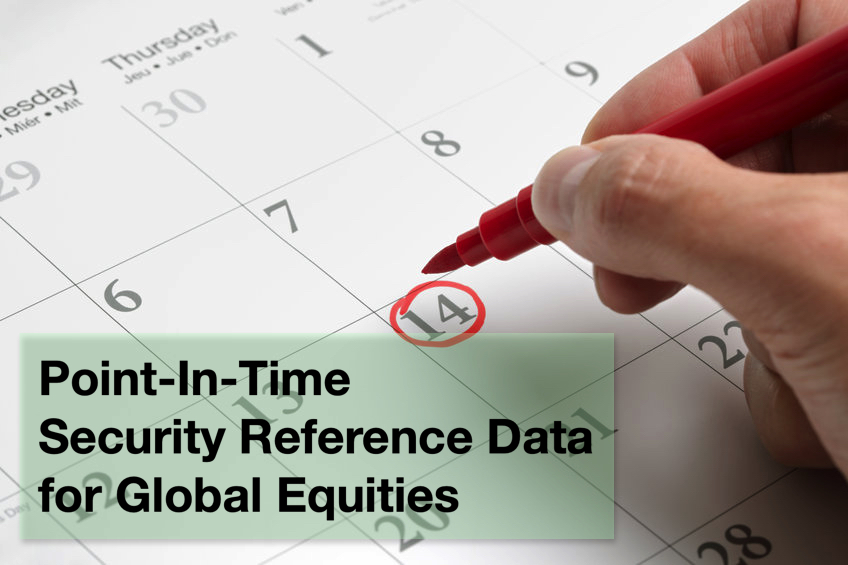Quickly Identify & Cross-Reference Global Securities.
Overview: In addition to Level 3 Depth of Book Data, Closing Stock Prices, Bond Prices, and Futures & Options Prices, DIH offers security reference data that consists of security identifiers (e.g. ticker symbol, ISIN, FIGI, CUSIP, and more industry-standard identifiers) along with their associated standing data for over 1.3 million listed and unlisted global securities.
Coverage: DIH’s security reference data covers equities, fixed income, and derivatives from over 180 countries.
History: We have data going as far back as 2002.
Updates: We update our data daily.
Delivery: You can receive our data in bulk files via download, S3 to S3, on-demand via API, or via your web browser.
License Terms: We license our data for either your internal use only or for display/redistribution to your clients. Unlike other data providers, DIH does not have purge clauses – so if you ever stop receiving data from us, you do not have to a ransom to keep the data you’ve already received and for which you’ve paid.
Pricing: Several inputs go into the pricing for our data. For example, do you want security reference data for all available countries/markets and securities, or a subset? How much history do you want? Do you want updates going forward? Contact us to learn more.
Our Security Reference Data Helps You Better Manage Compliance & Operational Risk.
As a participant in the capital markets, you must always be able to accurately identify entities, issuers, securities, and the counterparties with whom you trade. If you don’t, you can run afoul of your clients and regulators, not to mention expose yourself to potentially catastrophic risks.
Unlike other data, security reference data touches every part of your organization, from the front-, middle-, and back-office to IT and support teams. According to a 2012 report by Capgemini, 70% of the data used in financial transactions is security reference data. That is why inaccurate or incomplete data can have such dire consequences.
For example, a significant percentage of trade breaks (i.e. when a trade is not cleared & settled properly) are caused by poor quality security reference data. The costs to repair such trades are significant, and increase as errors pass through front- to middle- to back-office systems.
Trade executions can also be delayed due to bad security reference data. Such delays can have a direct impact on the cost of trading, especially amid faster trading speeds. Delayed trades can result in compliance issues with regulators, too.
Having incomplete, false, or badly integrated data during a transaction can result in the failure of the transaction, a loss in capital, and the additional expense of lost or further unnecessary labor for financial institutions processing the trade.
Bottom line… all market participants need complete and accurate security reference data.

What’s Included in Our Data.
Our security reference data includes security identifiers along with their associated standing data for over 1.3 million listed and unlisted global securities, including:
EQUITIES
- Stocks
- Exchange-Traded Funds (ETF’s)
- Preference Shares
- Warrants
- Depositary Receipts
- Structured Products
- Tradable Rights
- Unit Trusts
- Mutual Funds
- Government Bonds
- Corporate Bonds
DERIVATIVES
- Futures
- Equity & Index Options
Our data alerts you to new, deleted, and updated records so you can quickly identify and cross-reference securities. It also enables you to classify securities by the included Global Industry Classification Standard (GICS®) industry code.
Included in our data are such details as:
Issuer / Company: Complementary Identification Code (CIC), Central Index Key (CIK), Legal Entity Identifier (LEI), issuer name, Global Industry Classification Standard (GICS®) industry code, country of incorporation, etc.
Security: ticker symbol, International Securities Identification Number (ISIN), Financial Instrument Global Identifier (FIGI), security description, status, primary exchange, currency, par value, issue price, paid up value, voting rights, shares outstanding, etc.
Exchange / Market: listing date, listing status, Market Identifier Code (MIC), exchange name, country, local ticker, lot size, minimum trading quantity, market segment, etc.
SOURCES OF OUR DATA
All of our security reference data is sourced from exchanges and issuers around the world. Much of this raw data involves translating source documents each day from dozens of native languages to English. To ensure quality, at least two (2) sources are used when possible and all data is algorithmically and manually reviewed before being made available for download by our clients. This laborious process ensures the most complete and accurate data possible.
POINT-IN-TIME DATA
In addition to current security reference data, we also offer point-in-time data for global equities. So pick a date in the past, and see the security reference data that was in effect for that equity on that day.
For example, point-in-time security reference data is critical when doing a back-test. If your data is not presented point-in-time, you could be using inaccurate data in your research. This will pollute your analysis.

SECURITY REFERENCE DATA FOR DERIVATIVES
Get up-to-date security reference data on exchange-traded futures and options where the underlying asset is either an equity or index. Easily identify specific derivative contracts with their attached underlying security.
Our data for derivatives include:
- Root Code
- Ticker
- International Securities Identification Number (ISIN)
- Financial Instrument Global Identifier (FIGI)
- Bloomberg Global ID (BBGID)
- Alternative Instrument Indicator (Aii)
- Classification of Financial Instruments (CFI)
- Complementary Identification Code (CIC)
- Security Description
- Underlying Instrument Details
- Market Identification Code (MIC)
- Contract Size
- Exercise Style (American or European)
- Options Symbology Initiative (OSI) Symbol
- Expiry Date
- Strike Price
- Exercise Price
Who Can Benefit from Our Data?
Because security reference data is critical to so many facets of the capital markets, a wide variety of firms rely upon DIH’s data, including:
- Investment banks
- Brokerage firms
- Hedge funds (systematic & non-systematic)
- Asset managers
- Private equity firms
- Venture capitalists
- Proprietary trading firms
- High net worth investors
- Exchanges and trading venues
- Service providers (e.g. OMS, EMS, data vendors, etc.)
For example, the departments in the front-office of an investment bank include investment banking, capital markets, wealth management, sales & trading, and research.
The middle-office supports the front-office in the areas of technology, compliance, legal, and risk management. It checks whether deals negotiated by the front office conform to the agreements and also tracks profits and losses.
The back-office is involved in such critical functions as clearing & settlements and technology. It helps all departments function smoothly.
All of these departments benefit from having high-quality security reference data.
Maintaining Security Reference Data is Hard, Even for the Largest Firms.
Maintaining complete and accurate security reference data has always been challenging, but several factors have made it even harder in recent years:
- More Financial Instruments: Not that long ago financially engineered securities such as derivatives did not exist. Firms continue to innovate and create new financial instruments to meet their clients’ demands.
- Rise of Electronic Trading: Program/algorithmic trading volumes have exploded as high-frequency trading (HFT) strategies reduce trade sizes with a corresponding increase in trade volumes. Systems are strained to process all of that data with minimal latency.
- Increasing Regulatory & Compliance Pressure: Regulators have emphasized the importance of managing operational risk and the need for global data standards. Therefore, firms place a high priority on managing accurate and timely security reference data to feed their risk management systems.
All of these factors drive firms, small and large, to ensure they have the highest quality security reference data possible.
Flexible Updates & Delivery.
Our data is updated on a daily basis. This update process “follows the sun” with data from Asian markets becoming available for download first, followed by Europe, the Middle East, and Africa (EMEA), and finally by the Americas.
You may customize our data to best suit your needs. For example, specify the companies, instruments, exchanges, or countries from which you’d like to receive security reference data.
We provide a master file that includes all of the requested data as of that date. Then assuming you subscribe to updates going forward, we provide a delta file each day going forward with only the changes to the master file. A full refresh of data is also available upon request.
We offer several ways to access our security reference data:
Bulk File Download – For most of our clients, downloading our data in bulk files is most convenient. We can deliver files in various formats (e.g. CSV) via download, S3 to S3 transfer, etc.
API – Some use cases are better suited for on-demand delivery of specific data points via an API.
Web Browser – Search our data via your web browser.
